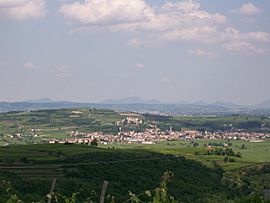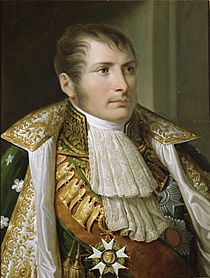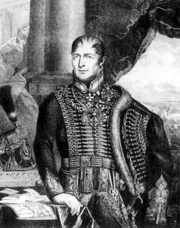Battle of Caldiero (1809) facts for kids
Quick facts for kids Battle of Caldiero (1809) |
|||||||
|---|---|---|---|---|---|---|---|
| Part of the War of the Fifth Coalition | |||||||
 Eastward-looking view of Soave. Castelcerino is out of the photo to the left along the crest of the ridge while San Bonifacio is a short distance beyond the right edge. |
|||||||
|
|||||||
| Belligerents | |||||||
| Commanders and leaders | |||||||
| Eugène de Beauharnais | Archduke John | ||||||
| Strength | |||||||
| San Bonifacio: 3,000 Soave: 23,000 Castelcerino: 5,000 |
San Bonifacio: 1,800 Soave: 18,000 Castelcerino: 6,000 |
||||||
| Casualties and losses | |||||||
| San Bonifacio: light Soave: 1,000 Castelcerino: 409 |
San Bonifacio: light Soave: 700 Castelcerino: 872 |
||||||
The Battle of Caldiero was a fight between the Austrian army and a combined French and Italian army. It happened from April 27 to 30, 1809. The battle took place near the towns of Soave and Castelcerino in modern-day Italy.
The Austrian army was led by Archduke John of Austria. The French and Italian forces were commanded by Eugène de Beauharnais, who was the Viceroy of the Kingdom of Italy. Even though the Austrians had fewer soldiers, they successfully defended against the attacks. This battle was part of the War of the Fifth Coalition, which was a larger conflict during the Napoleonic Wars.
Before this battle, Archduke John had defeated the French and Italian army. He pushed them back to the Adige River near Verona. Eugène, feeling embarrassed by his earlier losses, wanted to use his larger army to drive the Austrians out of Italy.
On April 27, Eugène's troops tested the Austrian defenses at San Bonifacio. On April 29, he ordered some of his soldiers to attack Soave. At the same time, an Italian force tried to capture high ground on the Austrian side. On April 30, the Austrians took back Castelcerino, which they had lost the day before. While this was happening, Archduke John's army began to retreat east. Caldiero is about 15 kilometers (9 miles) east of Verona. Soave and San Bonifacio are about 25 kilometers (16 miles) east of Verona. Castelcerino is a small village in the hills north of Soave.
Why the Battle Happened
At the start of the 1809 war, Archduke John of Austria was in charge of the Austrian forces in Italy. He had two main army groups, called Armeekorps. One was led by Johann Gabriel Chasteler de Courcelles and the other by Ignaz Gyulai.
Around the same time, people in Tyrol (a region in the Alps) started a rebellion against the Bavarians, who were allied with France. To help this rebellion, Archduke John sent about 10,000 Austrian troops to Tyrol. This meant his army in Italy became smaller.
Meanwhile, Emperor Napoleon was building up the French army in Italy. Many of these soldiers were actually Italians, as Napoleon had taken over parts of northern Italy. Eugène de Beauharnais, Napoleon's stepson, was made commander of this large army. Napoleon gave Eugène detailed advice on how to defend Italy. He told him to retreat to the Piave River if the Austrians attacked strongly.
On April 10, 1809, the Austrian army began to advance into Italy. They pushed west, forcing Eugène to send some of his troops to watch the Tyrol region. Eugène decided to gather his divisions at Sacile to fight the Austrians.
On April 16, Eugène attacked the Austrian army in the Battle of Sacile. Eugène thought he had more soldiers, but the Austrians actually had more cavalry and cannons. Eugène's attacks failed, and he had to order a retreat. The French and Italian forces lost about 6,500 men and 15 cannons. The Austrians lost about 4,000 men but won the battle.
After this defeat, Eugène's army fell back. They retreated first to the Piave River, then to the Adige River. Eugène was very embarrassed by his loss. Napoleon was angry and suggested that Eugène ask another general to take command. However, things soon started to get better for the French and Italians.
Eugène had sent many soldiers to protect the city of Venice. To keep an eye on this large force, Archduke John had to send away about 10,000 of his own troops. This meant John arrived at the Adige River with only about 28,000 soldiers. Meanwhile, Eugène received many fresh troops, bringing his total to about 55,500 men. With this larger army, Eugène prepared to attack.
The Battle of Caldiero
At the Adige River, Eugène reorganized his army into larger groups called corps. He put experienced generals in charge of these groups. For example, Jacques MacDonald led one corps, and Paul Grenier led another. Eugène himself commanded the reserve forces, which included the Italian Guard.
On April 27, a smaller fight happened at San Bonifacio. About 3,000 French and Italian soldiers defended the area. They were attacked by 1,800 Austrians. The Austrians managed to push the French and Italians out of San Bonifacio. However, they could not take the nearby village of Villanova. This fight ended with light losses for both sides.
On the same day, Archduke John learned that his brother had been defeated in another battle. John set up his army in a very strong defensive position. His right side was at Soave, behind a river, and his left side was at Legnago. He also placed soldiers on a hill north of Soave.
Eugène planned to attack the Austrian right side, hoping to push them towards Venice. He also hoped that the large French force in Venice would then attack the Austrians from the north. If this plan worked, John's entire army could be trapped.
On April 29, Eugène's troops attacked. An Italian brigade and the Italian Guard stormed a hill called Monte-Bastia and captured Castelcerino. At the same time, General Grenier led attacks on Soave and San Bonifacio.
Eugène sent about 23,000 soldiers into this fight. The Austrians had about 18,000 soldiers defending their positions. Even though the Italian Guard captured Castelcerino, Grenier's attacks on Soave and San Bonifacio were stopped. The French and Italians lost about 1,000 soldiers. The Austrians lost 400 killed or wounded and 300 captured. The Austrians won this part of the battle.
On April 30, Archduke John launched a counterattack with 11 groups of soldiers. They managed to take back the positions they had lost, including Castelcerino. The Italian troops had to retreat. The Italians lost 409 soldiers killed or wounded. The Austrians lost 300 killed or wounded, but 572 were missing. One of the Italian generals, Jean Joseph Augustin Sorbier, was badly wounded and died later.
After the Battle
On April 29, Archduke John received new orders. He was told to defend the land he had captured, but he could also decide what was best. John knew that Napoleon was moving towards Vienna, the capital of Austria. This meant his army in Italy could be attacked from the north. So, John decided to retreat from Italy. He wanted to defend the borders of Austria instead.
John's army began to withdraw on May 1. They destroyed all the bridges over the Alpone River to slow down the French and Italians. A general named Johann Maria Philipp Frimont led the Austrian rear guard, protecting the main army as it retreated.
Eugène's army started chasing the Austrians on May 2. They were delayed because they had to repair a bridge. In a series of smaller fights that day, the Austrians lost 200 soldiers, while the French and Italians lost 400. However, the French and Italians captured 850 sick or lost Austrian soldiers.
After these fights, Eugène made his light brigade (a fast-moving group of soldiers) even bigger. He put a new general, Joseph Marie, Count Dessaix, in charge. This new, larger division played an important role in Eugène's victory at the Battle of Piave River a few days later, on May 8, 1809.







